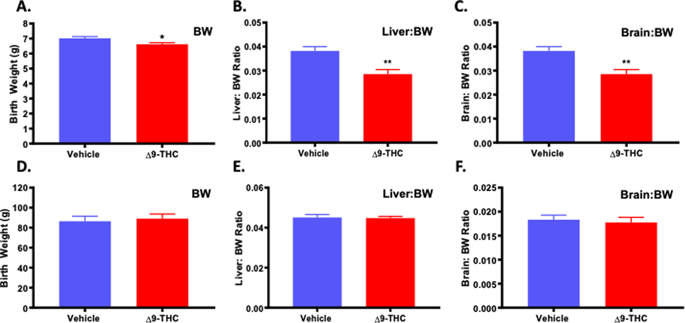Our official English website, www.x-mol.net, welcomes your feedback! (Note: you will need to create a separate account there.)
Δ9-tetrahydrocannabinol exposure during rat pregnancy leads to symmetrical fetal growth restriction and labyrinth-specific vascular defects in the placenta.
Scientific Reports ( IF 4.6 ) Pub Date : 2020-01-17 , DOI: 10.1038/s41598-019-57318-6 Bryony V Natale 1, 2 , Katarina N Gustin 2 , Kendrick Lee 3, 4 , Alison C Holloway 5 , Steven R Laviolette 4, 6 , David R C Natale 1, 2, 7 , Daniel B Hardy 3, 4, 8, 9, 10
Scientific Reports ( IF 4.6 ) Pub Date : 2020-01-17 , DOI: 10.1038/s41598-019-57318-6 Bryony V Natale 1, 2 , Katarina N Gustin 2 , Kendrick Lee 3, 4 , Alison C Holloway 5 , Steven R Laviolette 4, 6 , David R C Natale 1, 2, 7 , Daniel B Hardy 3, 4, 8, 9, 10
Affiliation

|
1 in 5 women report cannabis use during pregnancy, with nausea cited as their primary motivation. Studies show that (-)-△9-tetrahydrocannabinol (Δ9-THC), the major psychoactive ingredient in cannabis, causes fetal growth restriction, though the mechanisms are not well understood. Given the critical role of the placenta to transfer oxygen and nutrients from mother, to the fetus, any compromise in the development of fetal-placental circulation significantly affects maternal-fetal exchange and thereby, fetal growth. The goal of this study was to examine, in rats, the impact of maternal Δ9-THC exposure on fetal development, neonatal outcomes, and placental development. Dams received a daily intraperitoneal injection (i.p.) of vehicle control or Δ9-THC (3 mg/kg) from embryonic (E)6.5 through 22. Dams were allowed to deliver normally to measure pregnancy and neonatal outcomes, with a subset sacrificed at E19.5 for placenta assessment via immunohistochemistry and qPCR. Gestational Δ9-THC exposure resulted in pups born with symmetrical fetal growth restriction, with catch up growth by post-natal day (PND)21. During pregnancy there were no changes to maternal food intake, maternal weight gain, litter size, or gestational length. E19.5 placentas from Δ9-THC-exposed pregnancies exhibited a phenotype characterized by increased labyrinth area, reduced Epcam expression (marker of labyrinth trophoblast progenitors), altered maternal blood space, decreased fetal capillary area and an increased recruitment of pericytes with greater collagen deposition, when compared to vehicle controls. Further, at E19.5 labyrinth trophoblast had reduced glucose transporter 1 (GLUT1) and glucocorticoid receptor (GR) expression in response to Δ9-THC exposure. In conclusion, maternal exposure to Δ9-THC effectively compromised fetal growth, which may be a result of the adversely affected labyrinth zone development. These findings implicate GLUT1 as a Δ9-THC target and provide a potential mechanism for the fetal growth restriction observed in women who use cannabis during pregnancy.
中文翻译:

大鼠妊娠期间暴露于 Δ9-四氢大麻酚会导致胎盘对称性胎儿生长受限和迷路特异性血管缺陷。
五分之一的女性报告在怀孕期间使用大麻,恶心是她们的主要动机。研究表明,大麻中的主要精神活性成分 (-)-△9-四氢大麻酚 (Δ9-THC) 会导致胎儿生长受限,但其机制尚不清楚。鉴于胎盘将氧气和营养物质从母亲转移到胎儿的关键作用,胎儿-胎盘循环发育的任何损害都会显着影响母胎交换,从而影响胎儿生长。本研究的目的是在大鼠中检查母体 Δ9-THC 暴露对胎儿发育、新生儿结局和胎盘发育的影响。大坝从胚胎 (E) 6.5 到 22 接受每日腹膜内注射 (ip) 载体对照或 Δ9-THC (3 mg/kg)。允许大坝正常分娩以测量妊娠和新生儿结局,在 E19.5 处牺牲一个子集,通过免疫组织化学和 qPCR 进行胎盘评估。妊娠期 Δ9-THC 暴露导致幼崽出生时出现对称胎儿生长受限,并在产后日 (PND) 21 前赶上生长。在怀孕期间,母体食物摄入量、母体体重增加、产仔数或妊娠长度没有变化。暴露于 Δ9-THC 的妊娠的 E19.5 胎盘表现出一种表型,其特征是迷宫面积增加、Epcam 表达降低(迷宫滋养层祖细胞的标志物)、母体血液空间改变、胎儿毛细血管面积减少和周细胞募集增加,胶原沉积增加,与车辆控制相比。此外,在 E19。5 迷路滋养层响应 Δ9-THC 暴露降低了葡萄糖转运蛋白 1 (GLUT1) 和糖皮质激素受体 (GR) 的表达。总之,母体暴露于 Δ9-THC 有效地损害了胎儿的生长,这可能是迷宫区发育受到不利影响的结果。这些发现暗示 GLUT1 是 Δ9-THC 的靶标,并为在怀孕期间使用大麻的女性中观察到的胎儿生长受限提供了潜在机制。
更新日期:2020-01-17
中文翻译:

大鼠妊娠期间暴露于 Δ9-四氢大麻酚会导致胎盘对称性胎儿生长受限和迷路特异性血管缺陷。
五分之一的女性报告在怀孕期间使用大麻,恶心是她们的主要动机。研究表明,大麻中的主要精神活性成分 (-)-△9-四氢大麻酚 (Δ9-THC) 会导致胎儿生长受限,但其机制尚不清楚。鉴于胎盘将氧气和营养物质从母亲转移到胎儿的关键作用,胎儿-胎盘循环发育的任何损害都会显着影响母胎交换,从而影响胎儿生长。本研究的目的是在大鼠中检查母体 Δ9-THC 暴露对胎儿发育、新生儿结局和胎盘发育的影响。大坝从胚胎 (E) 6.5 到 22 接受每日腹膜内注射 (ip) 载体对照或 Δ9-THC (3 mg/kg)。允许大坝正常分娩以测量妊娠和新生儿结局,在 E19.5 处牺牲一个子集,通过免疫组织化学和 qPCR 进行胎盘评估。妊娠期 Δ9-THC 暴露导致幼崽出生时出现对称胎儿生长受限,并在产后日 (PND) 21 前赶上生长。在怀孕期间,母体食物摄入量、母体体重增加、产仔数或妊娠长度没有变化。暴露于 Δ9-THC 的妊娠的 E19.5 胎盘表现出一种表型,其特征是迷宫面积增加、Epcam 表达降低(迷宫滋养层祖细胞的标志物)、母体血液空间改变、胎儿毛细血管面积减少和周细胞募集增加,胶原沉积增加,与车辆控制相比。此外,在 E19。5 迷路滋养层响应 Δ9-THC 暴露降低了葡萄糖转运蛋白 1 (GLUT1) 和糖皮质激素受体 (GR) 的表达。总之,母体暴露于 Δ9-THC 有效地损害了胎儿的生长,这可能是迷宫区发育受到不利影响的结果。这些发现暗示 GLUT1 是 Δ9-THC 的靶标,并为在怀孕期间使用大麻的女性中观察到的胎儿生长受限提供了潜在机制。



























 京公网安备 11010802027423号
京公网安备 11010802027423号